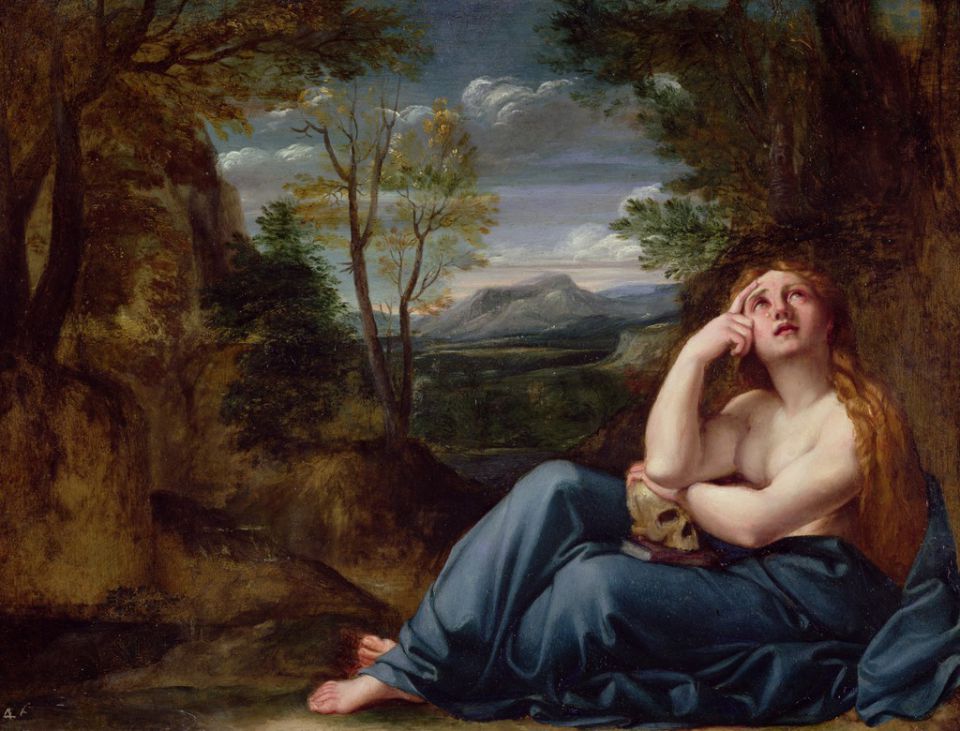QUINTILLAN - an incredible secret
the Tiny Village of Quintillan, near Durban - an amazing history. 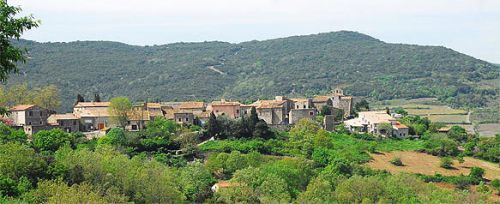
I arranged a visit to Quintillan because I wanted to see the church dedicated to Mary Magdalene. Quintillan is a remote village not far from Durban in the Corbières - from there go to Villeneuve, then Casastel, then Quintillan. It's incredible country that was well-known in Roman times, especially for its mines.
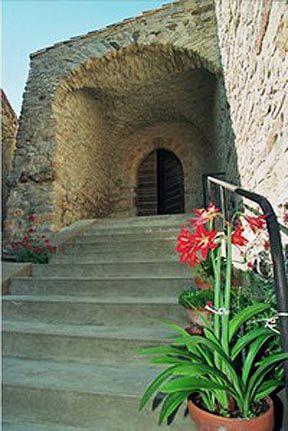
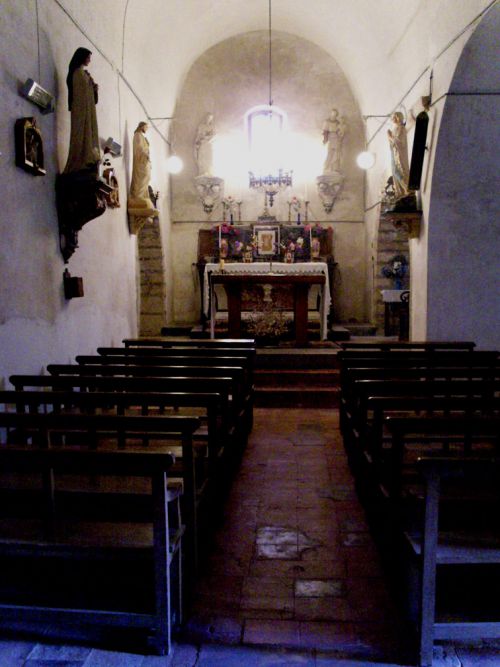
The steps up to the church - and inside it.
A French local history book told me the church is built on a rock and dominates the village. It gave 2 fete days for Quintillan, 22 July for Mary Magdalene and 2nd February, being Ste Eulalie's day. She was a third century saint who was martyred at Merida and is particularly popular in the south of Spain, the coast and the Balearics. But what was she doing in the Corbières?
The book said the local mines there were for copper and antimony, and the local marble was a particularly pleasant rose colour. The source of the river Berre is close to Quintillan. All the castles between Quintillan and the estuary of the Berre were built by the Visigoths.
Meanwhile, Les Corbieres, by Abbe Giry, Cure Marevene, and M. Bouille, says; The church of Mary Magdalene is planted on the rock and entirely covers it. The much restored nave is romanesque. Parts of the walls and the roof are dated 12th C. One km to the north was an ancient village, the map says hilltop, cliff or brook – this is called St. Martin and beside it the place called Sainte Eulalie. There's nothing much to see but certainly the church of Ste. Eulalie existed because there are ancient tombs. Under the humps and rubbish, are the ruins of old houses and several remains of Roman amphores, which means an old dwelling place was linked to the mines, for there are many slag heaps. It was an iron mine.
Indeed, on my map, IGN 2447 OT, the ruins of Ste Eulalie are marked, and a brook called St. Martin, about a mile north-west of today's Quintillan village.
The local web site, tells us Quintillan was named after the domaine of Quintillius. There wasn't a village, just various dispersed dwellings around the mines which became, by the 9th century, the parish of Ste Eulalie. When it became run-down, a new village grew up around the Ste Marie Madeleine church to the south-east. Ramparts were built in 1208. The church of Ste Marie Madeleine, mentioned around 1108, is remarkable for its bell-tower, walls, arches and its romanesque nave.
I wondered why was it dedicated to Mary Magdalene? Well, at the time Catharism was the prevalent religion. And the Cathars loved Mary Magdalene. And the village was fortified in 1208 – that would have been against Simon de Montfort.
Our visit
Built on the bedrock of the highest point of the village, the church is decorated very simply inside with some interesting statues. On the left of the altar is Mary Magdalene, conventionally represented with her vase of anointing oil and her cross. She is crying, tears are on her face. The crucifix was not used by Christians, and certainly not by Mary Magdalene, as a symbol of Jesus until the 9th century - but it is a Church convention that she holds a cross. Psychic people tell me it is significant that she is holding her wooden cross sideways, so it appear as a St. Andrew's cross. She has a cloak bunched around her in a strange way - could it be hiding the fact she was pregnant?
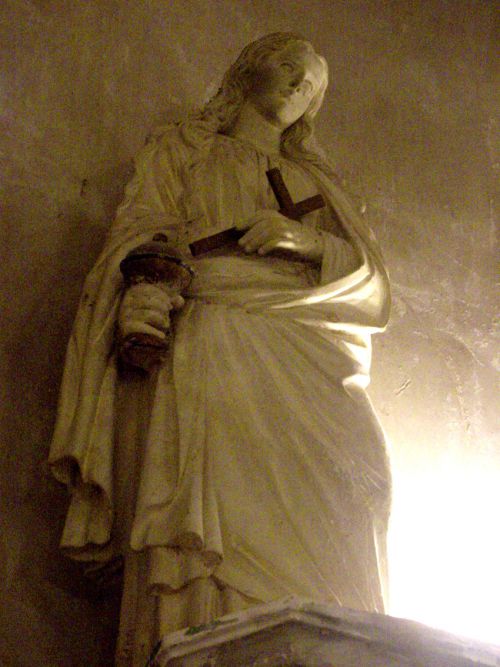
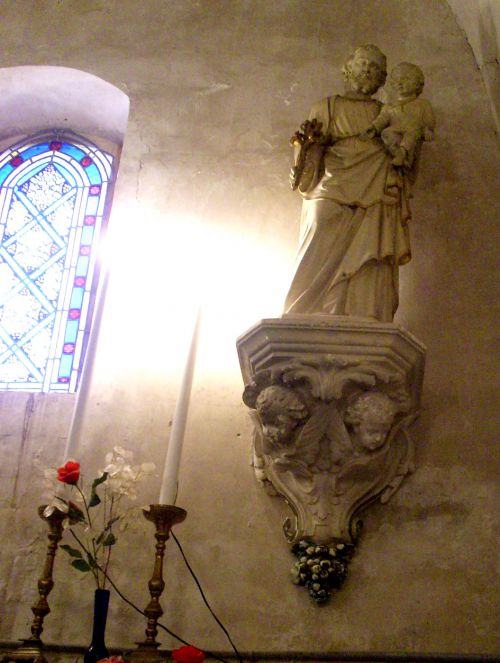
The statue on the right represents Joseph holding his baby Jesus. He too is strangely dressed, almost as though he is wearing a toga. Did the original sculptor mean anything by this? We will never know - but my imagination told me these two statues were of Mary Magdalene but not of Joseph; it was Jesus holding their child. These two are the two main statues either side of the altar.
Did you know the Gnostics considered the Trinity to be Father, Mother, and Son?
There were other images of Mary Magdalene in the church, a painting in the priest's room; and a model in the front of the pink marble altar.
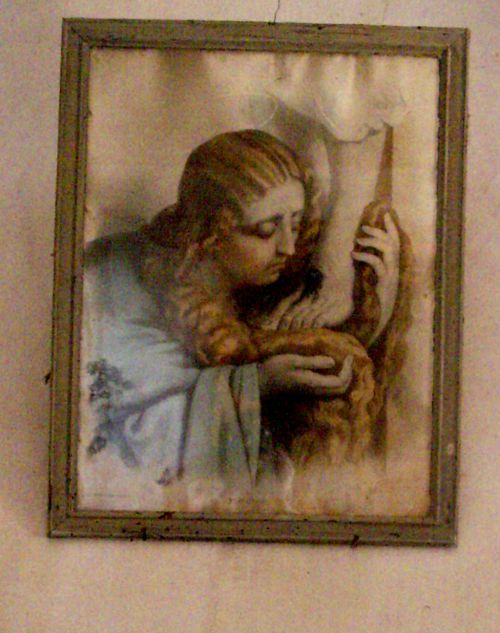
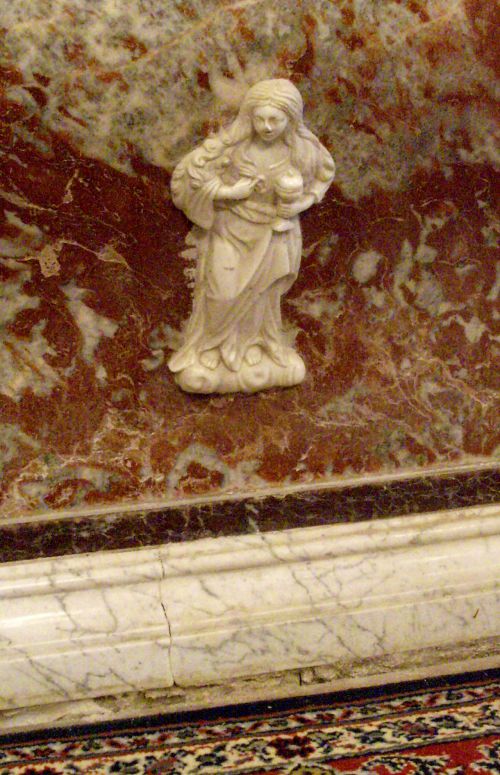
Then it was lunch time.
The only "cafe" in the village is the "Chambre d'Hotes" run by David and Jill Shortall. (If you can't find Suzette, who holds the key of the church, they can direct you.) The Mairie has given them permission to use the road in front of their house as a terrace and one can eat and drink there looking out over the valley and the vines. It was idyllic! With two colours of wine!
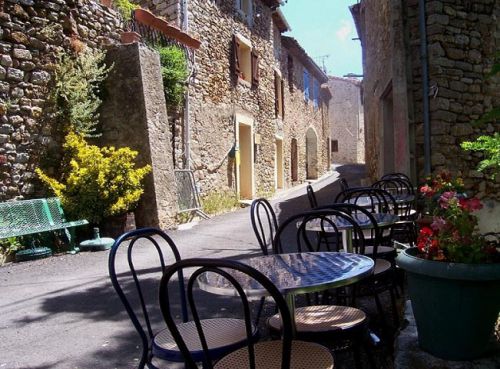
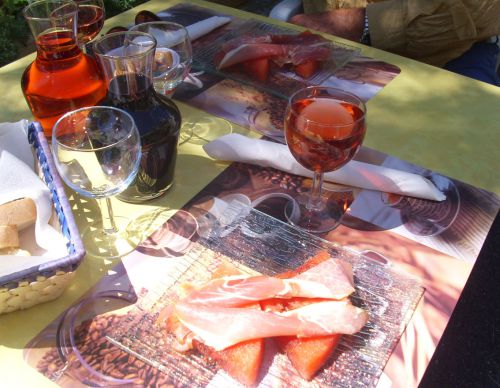
Jill Shortall is very knowledgeable about the region and the history of Quintillan. She told me today's village was founded in the 12th century and the church was the first building to be built. 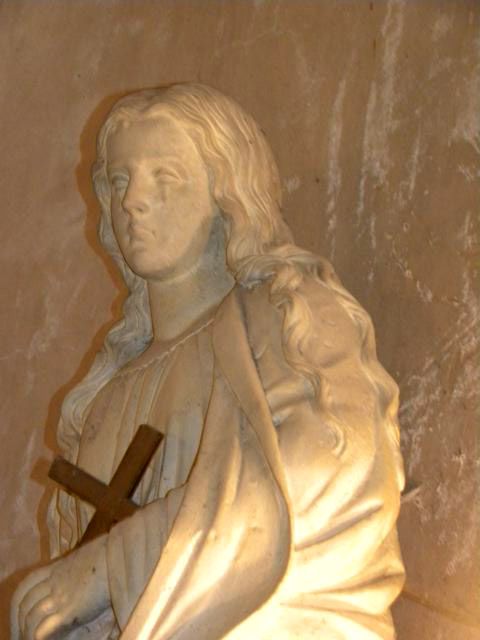
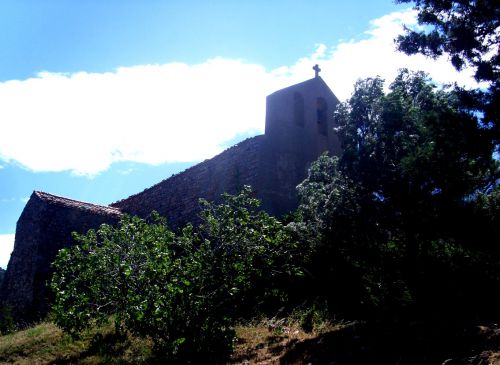
Mary Magdalene crying - and the church perched right on top of the hill
But I wanted to know more – I was intrigued by the name Quintillan, named ofter the Domaine of Quintillius. Who was he? I was quite surprised to find out!
Roman aristocrats
The first Quintillius, called Sextus Quintillus Varus, was a quaestor in 49BC and had defended Corfinium (in northern Italy) when Julius Caesar besieged the city during the civil war against Pompey.
On 15 March 44, Julius Caesar was assassinated by conservative senators like Brutus and Cassius. At the battlefield of Philippi, the new leaders of the Caesarian party, Marc Antony and Octavian, were fighting the Republicans, of which Sextus was one. The Republicans lost, and Sextus committed suicide.
The son of Sextus, Publius Quintillus Varus was born in 46BC. Publius became a personal friend of Octavian, later known as Augustus after becoming Rome's first Emperor. Publius Quintillus Varus, now known just as Varus, accompanied Augustus on his tour through the eastern provinces. After commanding the Nineteenth legion in Switzerland, Varus was made consul in 13BC, together with Tiberius, the stepson of Augustus. Tiberius and Varus introduced legislation that gave additional powers to their father-in-law Agrippa, who was now officially recognized as Augustus' equal in power. However, in the next year, Agrippa died. Varus gave the funeral oration. There was nothing now to stop Augustus becoming emperor.
Tiberius, regarded as the successor to Augutus, was Varus's friend, may have seen to his appointment as governor of Africa (modern Tunisia). The governorship of Africa was a very prestigious position: it was one of the provinces ruled by the Senate, rather than directly by the Emperor, and the only one with a legion, III Augusta. Varus ruled this part of the Roman world in 8-7 BC, but within a year was promoted as governor of Syria, where he had the command of one sixth of the Roman army.
In 7 BC, Varus arrived in Syria, a most important province. One of the vassal kingdoms was Judea, where Herod had been Rome's most loyal ally. The old king Herod, at the end of his reign, became paranoid and accused his son (and intended successor) Antipater of high treason. Varus, who had just arrived in Syria, supported the accusation, and Antipater was executed.
Three years later, Herod the Great himself died. In his will, he divided his kingdom among his three sons Herod Archelaus (Judaea and Samaria), Herod Antipas (Galilee and Perea), and Philip (Gaulanitis). Immediately, there were riots in the areas ruled by Archelaus, specifically Sepphoris, against Roman rule. The leaders were a robber named Judas, a royal slave called Simon, and a shepherd named Athronges. Archelaus' troops were unable to cope with this rebellion, and Varus had to intervene.
It was a major operation, which involved three legions. Sepphoris and Emmaus were destroyed, two thousand people were crucified, Herod Archelaus' territories were pacified and his reign could begin. After this, Varus returned to Rome, to receive triumphal ornaments.
Augustus had changed his mind about his succession: no longer did he believe Tiberius was the right man. Tiberius had left Rome and lived as an exile on Rhodes. Perhaps the former governor of Africa and Syria - Varus - had been too close to Tiberius to be fully trusted. We do not know of any offices occupied by Varus in these years. Although he was a patrician, he was also one of the new men who owed their career entirely to Augustus.
However, Augustus' new inheritors died, both when they were abroad. The result of this was that Tiberius, the stepson of Augustus and one of Rome's most experienced generals, was recalled from Rhodes as successor. He appointed his friend Varus as governor of Germania, probably in the autumn of 6 AD. Varus was married to the daughter of a niece of Augustus; they had a son Quintillus Varus, known now as Publius Quintillus Varus Junior.
The office of governor of Germania had been created in the years 16-13 BC, when the Romans had organized the strip of land along the Rhine and Danube as a military zone. The fortresses along the Rhine had served as base for the conquest of the east bank of the river. Germania had become part of the Roman empire. Like Gaul, it was expected to adopt the Roman way of life. Together with the legions of the army of the Lower Rhine (XVII, XVIII and XIX), Tiberius toured through Germania in 5 BC. It was meant as a show of strength, and the Germanic tribes understood that they were part of the empire - and would have to pay tribute.
In 6AD, Tiberius wanted to lead at least eight legions against king Maroboduus of the Marcomanni in Czechia. This was to be the most grandiose operation that was ever conducted by a Roman army. However, nothing happened, because a rebellion in Pannonia obstructed the execution of Tiberius' plan. It took three years to suppress the revolt.
The commander Gaius Sentius Saturninus was replaced by Varus, and the legions of the Rhine army were with Varus in Germania: sometimes in their winter quarters on the Rhine (Xanten and Cologne), sometimes on the eastern bank, for example at Haltern, where the presence of the Nineteenth legion is attested.
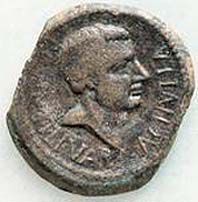 a coin struck for Varus
a coin struck for Varus
Varus was actively organizing the conquered territories between Rhine and Elbe. He collected taxes, founded new settlements and administered justice. In the summer of 9AD, the German leaders decided it was time to act: every German now knew what the Roman occupation meant, and several tribes preferred freedom to taxes. The tribes united under a man named Arminius. Varus was told there was a conspiracy under Arminius, but he was not convinced; he had been seduced by the friendship of Arminius. Varus and the three legions XVII, XVIII, and XIX were somewhere near the river Weser (perhaps near modern Minden) when he learned of an insurrection in the west.
Varus decided to make a detour through the rebellious area. The only road led through a small strip of accessible land; to the south, there were the inaccessible hills of the Teutoburg forest, and to the north, marshes made progress difficult. It was the perfect place to trap the heavy legionaries. And so it happened.
Suddenly Varus realised he had made a gross mistake in trusting Arminius. The three marching legions were a long line, easily exposed to attacks from the hills. All in all, some 20,000 people were massacred. Varus was obliged to kill himself.
The first reports of the disaster reached Rome: the emperor Augustus paced up and down through his house, exclaiming "Quintillus Varus, give me back my legions!"
The defeat of Varus had been one of the most decisive battles in world history. Varus' dead body was identified by the Germans, who cut off the Roman's head in the Celtic fashion, but a leader called Maroboduus sent Varus' remains to Rome. Augustus buried the head in the mausoleum of his own family.
Why are we so interested in Varus?
He was the governer of Syria, which included Judea, at the time when Jesus was born, and serving under Varus was a soldier called Pantera, the head of a cohort of archers, a cohort being between 500 and 1,000 men. Pantera was there at the time when the revolt was put down in Sepphoris, after the death of Herod the Great in 4BC, and Sepphoris is the legendary home of Anna and Joachim, the parents of the Virgin Mary.
Various rabbinical writings tell us that Jesus's father was a Roman soldier called Pantera, who lived from 24BC to 34AD. Celsus said that when Mary was pregnant she was turned out by the carpenter to whom she was betrothed, having been guilty of adultery with Pantera. Later Origen (185 - 254) wrote "Contra Celsum" disputing what Celsus had written, but first repeating what Celsus had said: Jesus was the "adulterous" son of a Roman soldier called Pantera. Other books even called Jesus - Ben Panthera, Ben Pantera, or Ben Pandera. In the Jerusalem Talmud, Jesus was known as Yeshua Pandera. Some writings called him a "mamzer" - the word translates as "bastard."
However, still today in Jewish law, children born out of wedlock bear no stigma unless the marriage between the parents would have been illegal anyway. Children of a married woman and a man not her husband are called mamzerim only because she could never have married him. Meanwhile, Pantera was Romanised; he was a mature man; the Roman law that said both men and women could only be married to one partner at a time. Hence, he could not marry Mary. In Jewish law, while men could be married to several women, women could only be married to one man, and the Virgin Mary was betrothed to Joseph. Betrothal was taken very seriously. If she was pregnant by Joseph before the marriage, no-one would have thought anything about it; but the Bible makes it obvious, that she wasn't.
The proof. . .
The Church claimed the Jews had invented the story of Pantera to slander Jesus.
Then, in 1859, in the town of Bingerbrück in western Germany, during the construction of a new railway, a Roman military cemetary was found. Many of the graves had upright tombstones on which were statues of the interred soldiers, with inscriptions below. One of these said; "Tiberius Julius Abdes Pantera of Sidon, aged 62, a soldier of 40 years of service, of the First Cohort of Archers, lies here." You can still see this tombstone in the museum of Bad Kreuznach, a few miles from Bingerbrück.
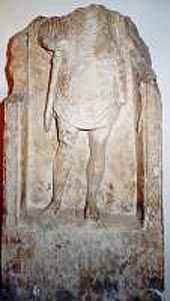 Pantera's tombstone
Pantera's tombstone
The Church was shocked. The man said to be Jesus's father in first and third century writings, really did exist. Bingerbrück is 20 miles west of Mainz, where the Nahe river reaches the Rhine. Eight legions were there under Germanicus whom Pantera joined in 9AD. Seven years later in 16AD, the Roman soldiers rebelled because they had done so many years of service and wanted to go home; many were in their sixties. This was the Rhine Mutiny, written about by Tacitus, which took place two years after the death of Augustus in 14AD, that is, in 16AD, for the soldiers hated and detested Tiberius, the new Emperor.
Pantera came from Sidon, on the Syrian coast to the north of Tyre in Gallilee, and obtained Roman citizenship under Tiberius after he had served 25 years in the army. He thus changed his name to that of the Emperor, as was common practice, but retained Abdes, which means, "Servant of God."
Pantera died during this fighting in 16AD; he had done 25 years of service; therefore his career as a soldier began about 10BC. At the time Jesus was conceived, around 3BC, Pantera would have been about 30 years old. But where was Pantera stationed at this time?
The First Cohort of Archers was stationed in Judea until 9AD when they went to the Rhine. Pantera and his Archers might well have supported the Roman military operations under Varus that suppressed a revolt at Sepphoris around the time of Jesus's birth.
Herod the Great, who had been appointed by the Romans in 37BC and established his capital and palace at Sepphoris, had died in 4BC. Immediately, an anti-Roman rebel called Judah ben Hezekiah, incited a revolt at Sepphoris, plundered the Herodian palace and armed the populace. The Roman governer of Syria, Quintillius Varus, responded promptly and destroyed the city. Many inhabitants were sold as slaves.
Therefore, the Virgin Mary and Pantera could have met at this time.
There's a story in the Bible that Joseph and the pregnant Mary were soon afterwards obliged to go to Bethlehem "to be taxed." There is no mention in Roman history of a great taxation at this time but there is evidence of something else. The Roman Emperor Augustus wanted to celebrate because the Senate had awarded him the title "Pater Patria" - Father of the Country - after 25 years of Imperial service. The date, the 2nd of February 2BC was coincidentally, 750 years after the founding of Rome. A great celebration was planned.
Augustus demanded an oath of allegiance from everyone in the Empire. Four million people had to sign by February 3AD - a year in advance. Judea was part of Syria and Quintillius Varus was the prefect. If Mary and Joseph "went to be taxed" to Bethlehem then Jesus was born around February 3AD, therefore he was conceived in May 4BC. Some people claim he was born under the sign of Aries, which makes his birth a little later - between 20th March and 20th April, 3BC, and his conception around June 4BC.
It adds up. All the dates it is possible to prove show that Pantera could have been Jesus's biological father. And Jesus rally was born in Bethlehem.
When things settled down in Sepphoris, Herod the Great's son, Herod Antipas, was made Tetrach of Judea in 1AD. He decided to make Sepphoris his showcase. It became a major site in the first century BC and Jesus in his teenage years, in the company of his step-father Joseph, would have known the town, with beautiful municipal buildings and large houses supplied with running water - the most-envied Roman luxury. Joseph worked there. But Sepphoris is not mentioned in the Bible.
The people of Sepphoris housed the Roman army of Titus when he came to quell the Jewish revolt of 66 to 73AD. The town was one of the most Romanised towns in Judea.
And Quintillan?
It was not Quintillus Varus that founded Quintillan, but his son of the same name. 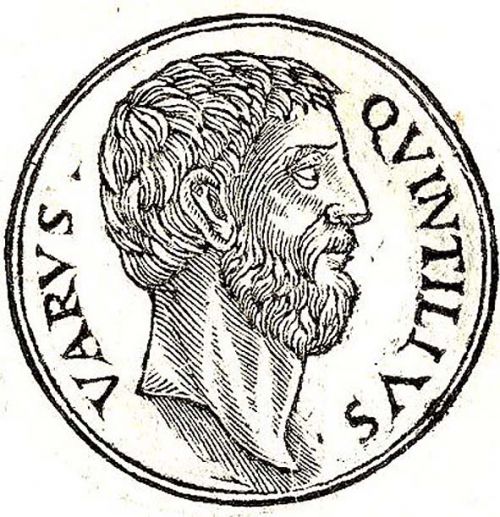 he looks like a miner, doesn't he?
he looks like a miner, doesn't he?
Publius Junior was a mining engineer and went to work or owned the mines there, that were founded about 50BC, when the Narbonne region, including the Corbières, was colonised. This last Varus died in Rome in 27AD simply because he was friendly with Sejanus, Tiberius's right-hand-man who fell suddenly into disgrace. Sejanus organised the marriage of Claudia Procula to Pontius Pilate in 26AD, not long before his life ended. Sejanus owned a villa at Sigean on the coast of Languedoc just south of Narbonne; the town was named after him.
Claudia Procula was instrumental in Mary Magdalene and Jesus coming to live in the region of Rennes-le-Château. More details are available here.
How much time Quintillus Junior spent in Quintillan we don't know; but it's likely that he would not have been popular in Rome after his father's disgrace, and thought, maybe he could climb back into favour with Sejanus, Tiberius's deputy. If so, that decision cost him his life.
The two knew each other evidently and Sigean is at the far end of the river Berre from Quintillan where it has its source. Maybe Quintillius Junior knew Claudia Procula, and knew she was being brought up in Narbonne. As today, the aristocracy lived a life quite different from their workers and visited in each other's houses. It wasn't far from Sigean or Narbonne to Quintillan.
Quintillus would have also been involved in the mining at nearby Palairac. The mines there were worked from antiquity, probably Celtic times around 50BC, and with 14 other villages, supplied the Roman Empire with iron, copper, silver, lead, antimony - and gold. For more about the mines in the area, click here. There were mines and in the towns of Tuchan and Padern, through which Mary and Jesus passed on the way from the coast to Rennes-les-Bains. Click here.
Now, nearly 2000 years later, this tiny village of Quintillan deep in the Corbières of Languedoc, hides an incredible history.
Inscrivez-vous au site
Soyez prévenu par email des prochaines mises à jour
Rejoignez les 254 autres membres
